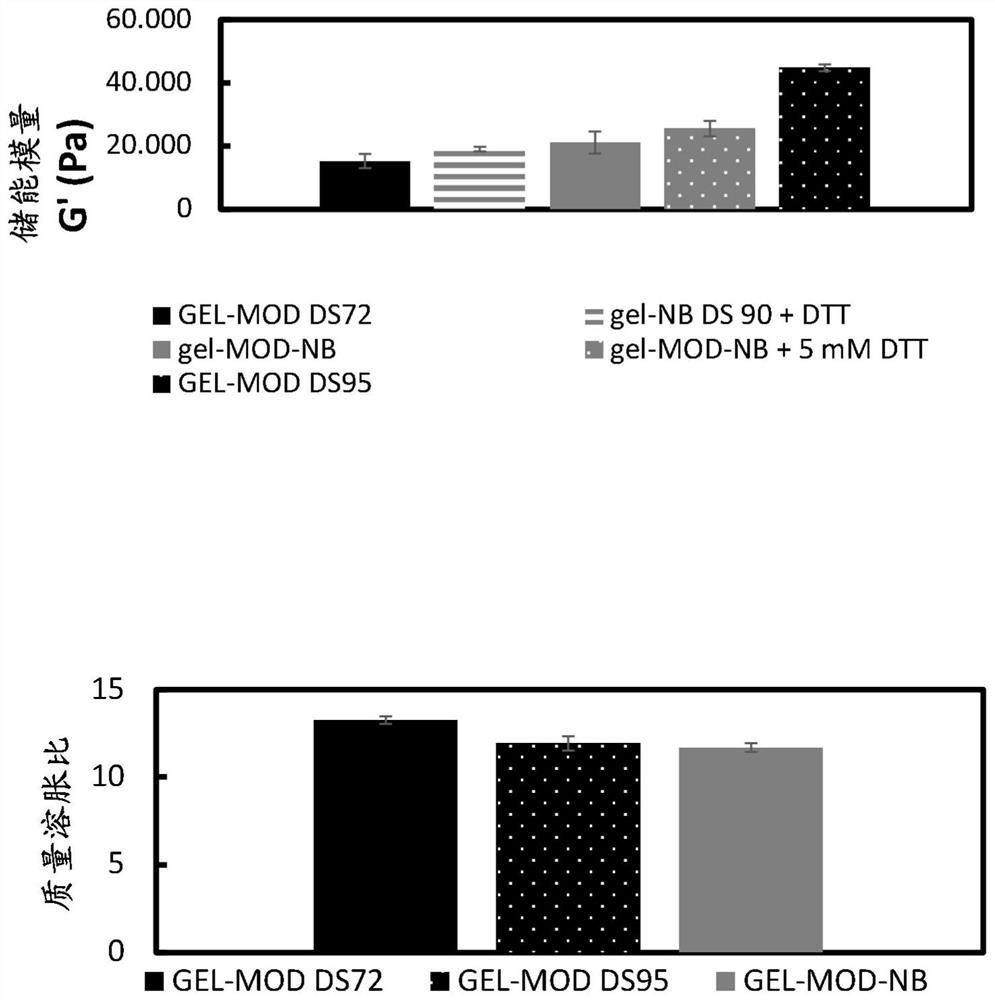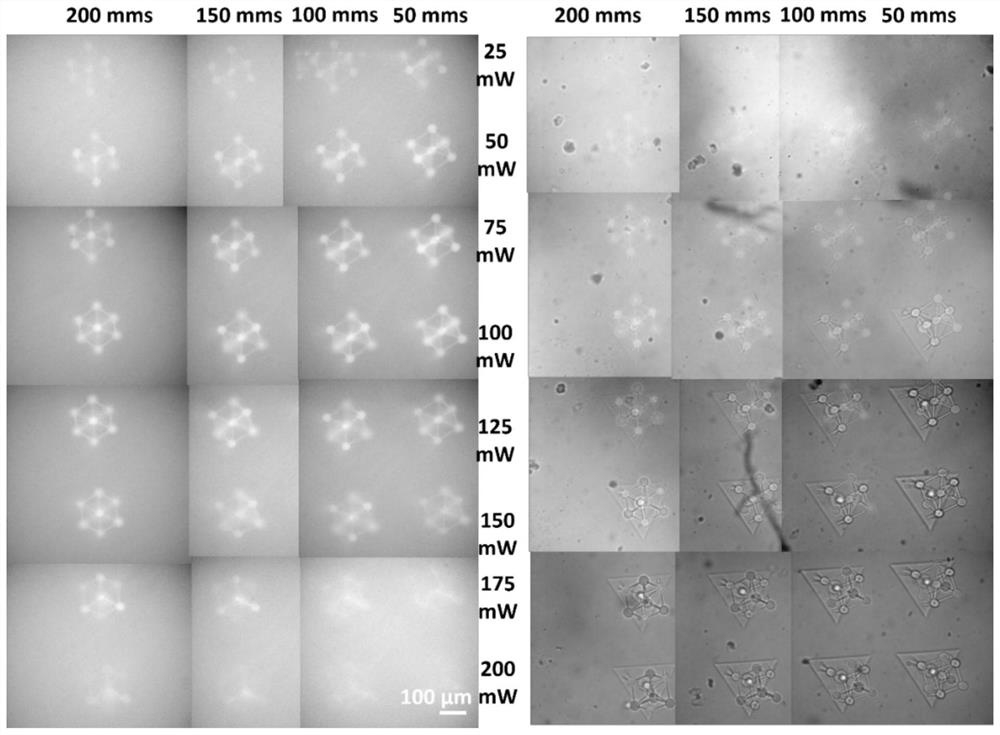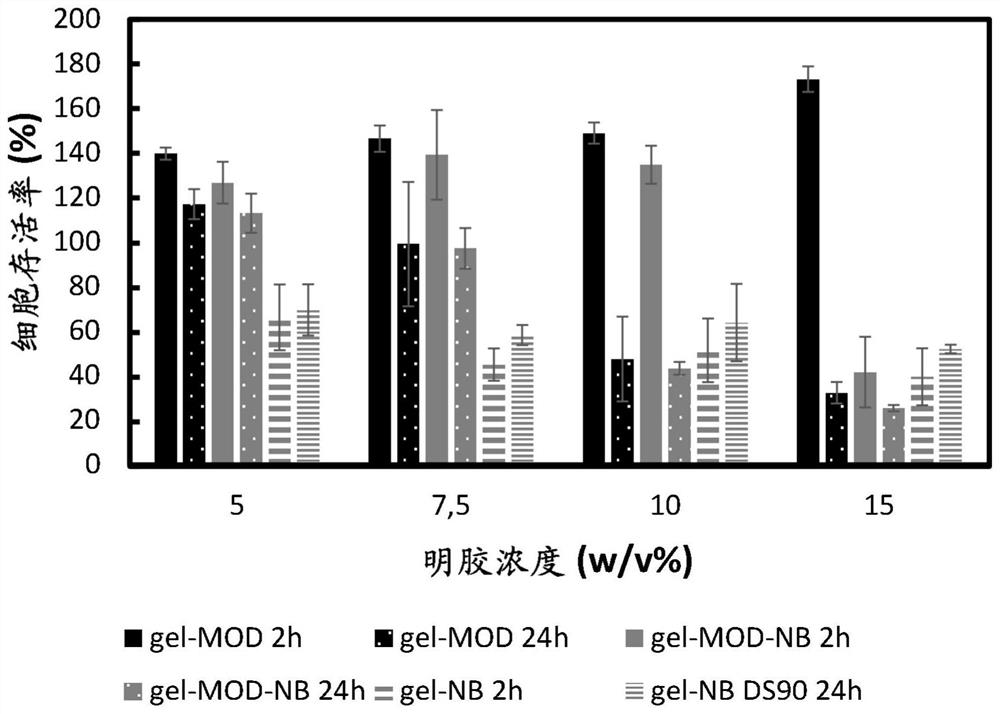Bifunctional modified biopolymer based polymers and hydrogels obtainable from such bifunctional modified biopolymer based polymers
A biopolymer, bifunctional technology, applied in chemical instruments and methods, animal/human proteins, prostheses, etc., can solve the problems of uncontrolled thiol-ene ratio, poor mechanical properties, elevated temperature, etc.
- Summary
- Abstract
- Description
- Claims
- Application Information
AI Technical Summary
Problems solved by technology
Method used
Image
Examples
Embodiment 1
[0095] Example 1: Preparation method and bifunctionalized gelatin (Gel-MOD-NB)
[0096] Material
[0097] Use the following chemicals:
[0098] - Gelatin type B, isolated from bovine hides by alkaline treatment, supplied by Rousselot (Ghent, Belgium).
[0099] -Methacrylic anhydride, 5-norbornene-2-carboxylic acid, 1-ethyl-3-(3-dimethylamino)propyl)-carbodiimide hydrochloride (EDC), D, L-Dithiothreitol (DTT) was from Sigma-Aldrich (Diegem, Belgium).
[0100] -Dimethylsulfoxide (DMSO) (99.85%) and N-hydroxysuccinimide (98%) (NHS) were purchased from Acros (Geel, Belgium).
[0101] - Irgacure 2959 (1-[4-(2-Hydroxyethoxy)-phenyl]-2-hydroxy-2-methyl-1-propan-1-one) from BASF.
[0102] - Dialysis membrane Spectra / por (MWCO 12-14 kDa), purchased from polylab (Antwerp, Belgium).
[0103] Preparation of Gel-MOD
[0104] DS (substitution degree) is 72% Gel-MOD according to in A.I.Van Den Bulcke, B.Bogdanov, N.DeRooze, E.H.Schacht, M.Cornelissen and H. Berghmans, "Structural and Rhe...
Embodiment 2
[0118] Example 2: Preparation method and bifunctionalized collagen (col-MOD-NB)
[0119] Preparation of col-MOD
[0120] Col-MOD was adopted in A.I. Van Den Bulcke, B. Bogdanov, N. De Rooze, E.H. Schacht, M. Cornelissen and H. Berghmans, "Structural and Rheological Properties of Methacrylamide Modified Gelatin Hydrogels", Biomacromolecules, Vol. 1 No. 1, Scheme described on pages 31-38, March 2000 and synthesized according to the following reactions:
[0121]
[0122] Briefly, 100 g of collagen was dissolved in 1 L of phosphate buffer (pH 7.8) at 40°C. After dissolution was complete, 1, 2 or 5 equivalents of methacrylic anhydride relative to the primary amine present in the (hydroxy-)lysine side chain were added and the mixture was vigorously stirred. After 1 h, the mixture was diluted with 1 L of double distilled water (DDW) and a dialysis membrane (Spectra / por MWCO 12-14 kDa) was introduced against DDW within 24 h. After dialysis, the pH of the mixture was adjusted to ...
PUM
 Login to View More
Login to View More Abstract
Description
Claims
Application Information
 Login to View More
Login to View More - R&D
- Intellectual Property
- Life Sciences
- Materials
- Tech Scout
- Unparalleled Data Quality
- Higher Quality Content
- 60% Fewer Hallucinations
Browse by: Latest US Patents, China's latest patents, Technical Efficacy Thesaurus, Application Domain, Technology Topic, Popular Technical Reports.
© 2025 PatSnap. All rights reserved.Legal|Privacy policy|Modern Slavery Act Transparency Statement|Sitemap|About US| Contact US: help@patsnap.com



